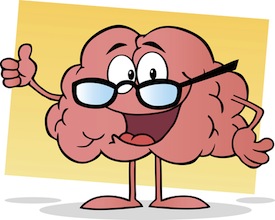New discoveries on brain research and learning – use these ideas to truly differentiate your classroom.
Can our brains actually grow new dendrites when the cells are stimulated through unique and novel situations? Does the human mind really “prune” out cells that are rarely or never used?
It appears to be true. Researcher Kathie Nunley wrote an article called Brain Biology: It’s Basic Gardening in which she clearly states the evidence behind this in brain research and education.
Learning new material requires higher brain functioning.
There are brain training exercises that can help, but it is more about what we do in the classroom that contributes to the brain shutting down.
High activity in certain regions requires heavy blood flow to the cells. Low activity areas get less. These areas build up calcium ions, which trigger the release of the enzyme Calpain. This makes the lesser used nerves self-destruct.
So, could we, as educators, actually contribute to the brain destroying itself or growing? It seems likely.
Brain & Mind Learning Principles
Geoffrey and Renate Nummela Caine wrote a book called Brain/Mind Learning Principles in Action: Developing Executive Functions of the Human Brain. The book gives a foundation for the general rules of learning and can guide teachers in choosing best practices and strategies for teaching.
The 12 Principles are:
1. All learning is physiological.
2. The Brain-Mind is social.
3. The search for meaning is innate.
4. The search for meaning occurs through patterning.
5. Emotions are critical to patterning.
6. The Brain-Mind processes parts and wholes simultaneously.
7. Learning involves both focused attention and peripheral perception.
8. Learning always involves conscious and unconscious processes.
9. There are at least two approaches to memory: archiving individual facts or skills or making sense of experience.
10. Learning is developmental.
11. Complex learning is enhanced by challenge and inhibited by threat associated with helplessness.
12. Each brain is uniquely organized.
Zone of Proximal Development
Brain-based education is the engagement of strategies based on principles derived from an understanding of the brain. The ZPD (Lev Vygotsky) is the zone in which learning actually occurs. All students Zone of Proximal Development is different, so they must be working at different levels within their Zone.
Vygotsky stated that if students who have similar ZPD work together, then their learning will be optimized. However, do not place students in groups that are above their ZDP. This will only lead to frustration as they are not yet ready to work at that level.
Too often we have students working in their Zone of Actual Development (ZAD). This is where students work completely independently with no support needed from the teacher.
Not only does true learning not take place in this zone, and it is contradictory to the principles behind brain research and learning. The work is too easy and the student needs more challenging work to get in to the Zone of Proximal Development.
Brain research in education has shown that learning occurs with “moderate challenges and relaxed alertness,” (Jensen, 1988). At times educators tend to give too much of a challenge, and this will actually release the stress hormone cortisol.
This is important: Brain research and learning studies have shown that cortisol actually kills neurons and hampers cognition.
- Pretest to find the ZPD
- Provide controlled choices
- Place students in similar ZPD groups to avoid frustration
- Scaffold the learner through more complex tasks
If your students are stressed in your class and feeling as if they cannot understand you or will fail, you are actually killing parts of their brain (sounds crazy right? It isn’t).
In simpler terms, lessons should neither be too easy (no learning) nor too difficult (no learning). Aim for the middle where they student needs just a bit of help from you or group members to successfully accomplish the task.
Taking a brain break can also make a big difference to how successful students are with difficult tasks.
Brain Research and Learning: Challenging the Brain
How to Challenge Our Students Brains
| When in doubt, teach up. Aim slightly above the Zone of Proximal development when presenting a lesson. |
| Provide frequent feedback and opportunities for students to “check-in.” |
| If mastery is present, give something different (not more of the same). |
| Utilize Blooms Taxonomy questions for evaluation. |
Dr. Marian Diamond says that dendrites on neurons extend as the brain is in an enriched environment (Magic Trees of the Mind : How to Nurture Your Child’s Intelligence, Creativity, and Healthy Emotions from Birth Through Adolescence ).
Her research showed that when positive socialization and challenges are combined, “brain growth” does occur.
Eric Jensen reports in his book Teaching with the Brain in Mind, Revised 2nd Edition that students who are involved in challenging activities experience 25% more brain growth than those who are not.
Presenting an adequate challenge to our students is certainly supported by brain research and education.
